|
|
|
|
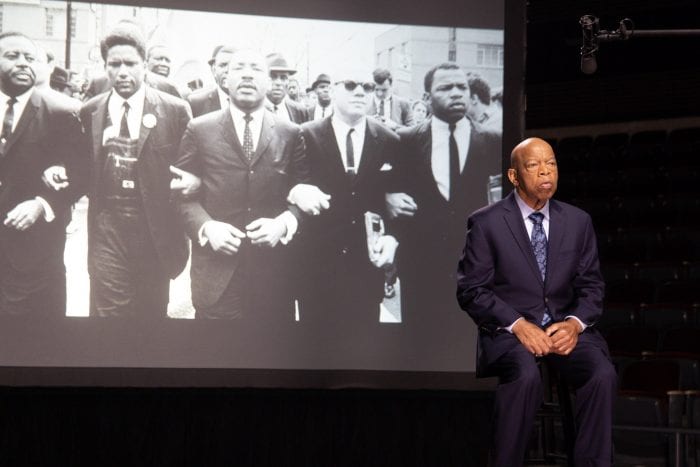
Reviewed By Jeffrey Sanzel
Freedom is not a state; it is an act. It is not some enchanted garden perched high on a distant plateau where we can finally sit down and rest. Freedom is the continuous action we all must take, and each generation must do its part to create an even more fair, more just society.
— Across That Bridge: A Vision for Change and the Future of America by John Lewis
When Congressman John Lewis passed away on July 17 at age eighty, the world lost the man who was called “one of the most courageous persons the Civil Rights Movement ever produced.” Lewis was a beacon for the protection of human rights and won the respect and admiration of colleagues on both sides of the aisle.
Having dedicated his life to the Civil Rights movement, he was a member of the “Big Six” who organized the legendary 1963 March on Washington. In 1965, he led the first of three Selma to Montgomery marches across the Edmund Pettus Bridge. In the infamous Bloody Sunday (March 7, 1965), he was one of the nearly six hundred marchers who were viciously attacked. Lewis suffered a skull fracture, and he bore the forehead scars for the rest of his life.
Now, Dawn Porter has directed the powerful and absorbing documentary John Lewis: Good Trouble. The title refers to a belief that Lewis held his entire life:
Do not get lost in a sea of despair. Be hopeful, be optimistic. Our struggle is not the struggle of a day, a week, a month, or a year, it is the struggle of a lifetime. Never, ever be afraid to make some noise and get in good trouble, necessary trouble.
Lewis said that age fifteen he was inspired by Dr. Martin Luther King Jr. and Rosa Parks to get into “good trouble.”
The ninety minutes are a portrait of a man of deep belief and unfathomable courage. Much of the film focuses on the all-important voting rights. Instead of taking a traditional linear biographical approach, it alternates between his work in the 1960’s with his continued work in the 2000’s. Porter is clearly drawing a parallel between the two eras. The first where there was a struggle to secure equal voting opportunities for African Americans and other minorities, and the present where these secured rights are once again imperiled.
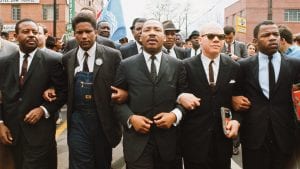
The documentary opens with and frequently returns to Lewis watching film footage of the Civil Rights movement in the 1960’s, much of which he has never seen. In his stillness is the wisdom of a man who has seen much and experienced more. His pain is mixed with pride and awareness. Occasionally, he comments on what he is watching, but mostly he just takes it in. It is incredibly moving in its simplicity as he reviews many of the most disturbing moments in a long history.
Interspersed with archival clips, many featuring Dr. Martin Luther King Jr. as well as John F. Kennedy, Robert Kennedy (for whom Lewis worked at the time of his assassination), George W. Bush, Ronald Reagan, Lyndon B. Johnson, and Barack Obama, are short interviews including Hillary Clinton and Bill Clinton, Elijah Cummings, Nancy Pelosi, Alexandria Ocasio-Cortez, Cory Booker, and Ilhan Omar, all praising the Congressman’s work and his commitment. These help shape the overall picture of Lewis and his journey.
He is shown on the campaign trail with young, vibrant contenders, frequently first time candidates. Beto O’Rourke and Stacey Abrams are just two of the many he has supported. There are wonderful clips of his unchecked joy watching the returns of the 2018 mid-terms.
The film gives only a sketch of his personal life and history, with appearances of his sisters and brothers, who clearly love him but remain slightly in awe of his accomplishments. His wife and son are briefly touched upon, and her passing in 2012 was clearly a blow. There is a brief bit about his friendship with Julian Bond that turned acrimonious when they ran against each other. Few details are given but clearly this was a difficult personal time in his career.
What continues to come across is Lewis’s incredible warmth and generosity, a gentle leader and a continuing inspiration. His humor is in stark contrast with the often fiery passion he shows when speaking. His speeches are mesmerizing in their raw honesty. These are as much a part of him as are the amusing anecdotes that are introduced throughout. (His preaching to the chickens as a boy can only be appreciated by listening to his telling.)
A viral dance, his reaction to the election of President Obama as well as that president’s gratitude towards him, and his easy banter with his longtime chief of staff, Michael Collins, are just some of the glimpses into his gracious humanity. His message of non-violence is continually emphasized. The right to protest but the responsibility to do it without intentional harm was deeply rooted in his choices and actions.
But central to the film and Lewis’s story is the quest to eradicate voter suppression. This is been the head and heart of Lewis’s life. In addition to the many important moments of the 1960’s is the bipartisan Voting Rights Act of 2006. The subsequent 2013 attack on it led to the 2016 election being the first without the protection of this act.
I fear that we are facing the end of democracy. As long as I have breath in my body, I’ll do what I can.”
The film builds to a quick sequence highlighting the dozens of bills that Lewis co-sponsored, the breadth of his work including not only voting and civil rights but gun control, health care reform, immigration, and a host of other important social issues. It is clear that his goal has been to make a better, freer, and more equal world:
As a nation and a people, we are not quite there yet; we have miles to go.
Porter never shies away from presenting disturbing and often brutal images, including attacks during marches, sit-ins, and lunch counter desegregations. There is nothing sensationalist about her choices; they are an honest representation of a dark blot on our country’s history. But the film truly honors the spirit and accomplishments of John Lewis. It is a documentary that should be viewed by families and seen in classrooms, discussed, contemplated, and taken to heart. The final words of the film are appropriately his:
We will create a beloved community. We will redeem the soul of America. There may be some setbacks, some delays … but as a nation and as a people, we will get there. And I still believe, we shall overcome.
Rated PG, John Lewis: Good Trouble is now streaming on demand.
|
|
|
Join Cold Spring Harbor Laboratory for an online live panel Q&A discussion via Zoom about the documentary film, “Human Nature, on Monday, Aug. 17 at 6 p.m. Moderated by Elliot Kirschner, panelists Jennifer Doudna, Alta Charo, Elliot Kirschner, and Zachary Lippman will discuss the story of CRISPR genome engineering as the biggest tech revolution of the 21st Century with far-reaching implications for science, ethics, and all of humanity. Visit www.cshl.edu for link. Call 516-367-8800 for more info.
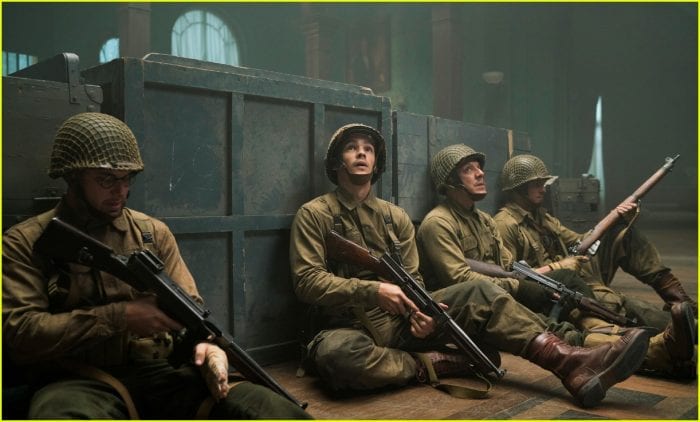
Reviewed by Jeffrey Sanzel
The tagline to the new horror movie Ghosts of War is “The Enemy Isn’t Out There. It’s in Here.” If “in here” meant the studio, I would agree with that. Ghosts of War is presented as a thriller that traces descent into madness. However, writer/director Eric Bress (The Butterfly Effect) misses almost every opportunity to deliver something that is more than just a series of clichés.
The film opens in Nazi occupied France, 1944. The five remaining members of an American troop are ordered to guard a French chateau that was recently occupied by the Nazis. After an opening sequence in which they dispatch a Nazi unit and then aid escaping or refugee concentration camp survivors, they arrive at their destination. (The anachronisms become both clearer and muddier as the film progresses.)
The soldiers who have been holding the mansion until now hightail it out … as if haunted by their experiences there. Subtlety is not Bress’s strong suit. Nor is dialogue or character development.
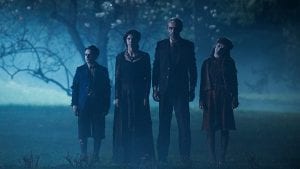
Within minutes, there is a clumping parade of almost every old-dark-house trope: weird stains and burn marks on the carpet; rows of staring dolls; a wine cellar with a strange family photo; a locked trunk; garbled breathing sounds from ornate vent grates; matches blown out without a breath of air; strange voices in locked rooms; a silhouette of a hanged man that disappears when the curtains billow; doors that swing open suddenly; mysterious footsteps overhead; claw marks on the floor; a pentagram in the attic; … and everything accompanied by a swift camera pan and a crash of the soundtrack.
All of this all happens in about fifteen minutes. One then ponders what they’re going to do for the next hour.
Well … they’re going to talk. They’re going to have a vulgar exchange of stories and urban legends; this is to show that they’re “men.” Then they’re going to have serious philosophical discussions about the nature of evil. And still there’s fifty minutes to go — so Bress recycles the strange voices and the odd knocking and adds some screeching ghosts. (There is one clever piece where the banging actually communicates Morse code.)
The shame is that there are real hints of possibility. Clearly, these five men have been damaged by their wartime experiences. The pain lying underneath the bravado could have been harnessed to tell a story about soldiers transitioning from battle to PTSD. But, instead, Ghosts of War is stilted and predictable. Lines like “I’m not sure what I saw” are followed by quasi-intellectual explorations of the supernatural.
A reference to the Ambrose Bierce short story, “An Occurrence at Owl Creek Bridge,” and the possibility that they are dead is neatly connected to their speculation on this being their own personal Hell, forced to relive a loop of the same moments. Again, a great idea that is squandered as they return to the same screams and jumps.
A journal left behind reveals that the castle’s residents had hid Jews before they were caught and brutally murdered by the Nazis. It is their spirits that are trapped in the house. Laying them to rest becomes the soldiers’ quest. There is a brief interlude where a random Nazi patrol enters the house and is dispatched by both the Americans and the ghosts — before the ghosts once again turn on the Americans.
Skylar Astin does his best as the “smart one” — he’s the “smart one” because he’s wearing glasses and plays classical piano. Brenton Thwaites finds a decent if predictable footing as the group leader. Kyle Gallner’s sniper is a bit over-the-top twitchy but he’s the only one given any history, including a monologue about his murder of a group of Hitler Youth.
Theo Rossi and Alan Ritchson are fine with what they are given but don’t make much impression. Unfortunately, none of them seem to have any internal background to drive the characters’ motivations. In addition, they are saddled with so much expositional dialogue about hauntings and earthbound spirits that they become overly articulate and lose any individuality.
In the final fifteen minutes of the film, the theme shifts from horror to almost science fiction. What could become an interesting twist about the power of guilt instead becomes a confused and unrealized concept that builds up to literally — and infuriatingly — no ending. The film stops as it is on the cusp of a possible resolution.
It just
(Like that.)
Rated R, Ghosts of War is now streaming on demand.
Reviewed By Jeffrey Sanzel
The Arthurian legend has been seen in films and on television for over one hundred years. Whether it is Disney’s animated The Sword in the Stone (1963), the screen adaptation of Camelot (1967), Monty Python and the Holy Grail (1975), or the gritty but effective Excalibur (1981), the tale and the characters have endured. King Arthur and Queen Guinevere, the wizard Merlin and the Knights of the Round table — all are drawn from Sir Thomas Mallory’s epic fifteenth century Le Morte d’Arthur. The stories have been told and retold, celebrated and spoofed over centuries.

Netflix’s most recent offering is the ten-part series Cursed. Based on the 2019 novel by Thomas Wheeler and illustrated by Frank Miller, this is a reenvisioning of the legend told through Nimue, who would become the Lady of the Lake, the sorceress who is often associated with giving Arthur the sword Excalibur and later enchanting Merlin. In many ways, Cursed nods most towards The Mists of Avalon, Marion Zimmer Bradley’s modern reinterpretation that emphasizes the powerful women behind Camelot.
The first episode opens with a cluttered exposition, assaulting the viewer with the series’ lore. An amazing amount of information and jargon are stuffed into fifteen minutes.
Nimue (Katherine Langford) is a member of the Sky People, one of the various Fey (fairy) tribes. She has gifts that are associated with witchcraft so is an outcast even among her own people. Her mother, Lenore (strong and kind as played by Catherine Walker), a healer and a pillar of strength in the tribe, tells her to never to be embarrassed of what she is.
Nimue is unsure of the source of her powers and they seem to manifest when she is upset or feeling a strong emotion — sort of a medieval Carrie White. That is, until she whimsically wins a dice game about twenty minutes later. (So much for consistency.) Mostly, they present as tree roots coming to life and graphically attack her persecutors. In a ritual offering by the community Elders, Nimue is chosen by the Hidden as the Summoner. This displeases the Elders and she decides to leave the community.
Along with her rustic sidekick, Pym (mostly comic relief as played by Lily Newmark), she flees to a port town, only to discover that the ship she sought left the day before. Here she meets Arthur, the man-who-will-be-king, (Devon Terrell) in the standard market day scene. They do end up have a sexy, fireside duel. Actual engagement doesn’t occur for another eight episodes.
The first part ends with Nimue in a sword battle against some badly CGI-ed wolves. This brands her the Wolf Blood Witch.
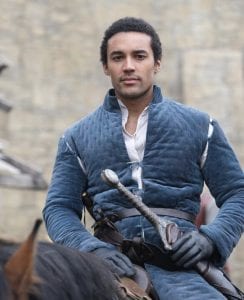
The sword is at the heart of the narrative, representing both honor and corruption. It goes by the name of the Devil’s Tooth and the Sword of First Kings and the Sword of Power. Nimue’s mother charged her with getting the sword to Merlin (Gustaf Skarsgård) and much of the first half of the series focuses on that quest.
While Cursed is a fantasy realm where both the flora and the fauna are enchanted, it is also a harsh, cruel, and bloody world — with emphasis on the bloody. It is not so much gallons of spilled blood but oceans. The number of slashings, knifings, and beheadings per episode is in the dozens. There is much more sword than sorcery in Cursed, and it is not for the squeamish.
Most interesting is the unrest in the world. There is drought and plague and it is being blamed on King Uther Pendragon (Sebastian Armesto) and the various Fey enclaves. Father Carden (Peter Mullan) and the Red Paladins are a religious order under the guidance of Rome; they are shown destroying the Fey villages and mutilating its denizens. There is the mix of zealot fanaticism and sadism in the Paladins as they destroy everything in their paths, burning and hacking their way in the name of right. They also torture their prisoners and burn them alive on crosses.
The tone is a strange blend of the traditional “Once upon a time …” with ABC’s Once Upon a Time. The dialogue is an odd mixture of modern and “oldey-timey,” with a scattering of milady’s but stopping short of “prithee” and “forsooth.” There is one stray “hedge-born naïf.”
The cast is, for the most part, very good. Langford makes Nimue strong and dimensional and carries the series well with charmingly honest Terrell an ideal match. Skarsgård’s Merlin is wily and dissipated, playing him with the right touch of ambivalence. Daniel Sharman’s Weeping Monk, the Paladin’s secret weapon, is appropriately menacing. Matt Stokoe’s Green Knight/Sir Gawain is proud but decent with a particularly strong moment where he relates the death of his brother. Aremsto’s spoiled king as a good match for Polly Walker’s cold-blooded Queen Regent mother. Mullan clearly understands the vicious, self-righteous monk. Shalom Brune-Franklin as Arthur’s sister Igraine/Morgana is a voice of reason until she isn’t.
Emily Coates is a bit more than psychotic as the rebel nun, Sister Iris — watching her walk away from the burning convent is chilling. Peter Guinness gives a richness to Sir Ector, Arthur’s uncle, who is more than reluctantly forced into the middle of the political mire.
There are dozens of characters who come and go (many with hatchets and swords in their chests; some missing hands). The villains tend to be pure evil which undermines the texture of the world. There are also Vikings and mercenaries and a variety of Fey to keep track of.
One nice touch is the animated illustrations that join the scenes. These clearly reference the Frank Miller illustrations from the book but they give a certain tone and flow that is aesthetically very elegant.
The problem with the series is the lack of consistency in the storytelling. The occasional stabs at humor don’t land well. While the first six episodes are dense with plot and background, they are well-paced. However, by episode seven, it all becomes predictable, and there is a sense of treading water (or blood) until the final episode and the great battle. By this time, the viewer is battle-fatigued and the fact that so much is left unresolved is both frustrating and predictable.
There is a moment in the penultimate scene that is a wonderful reveal which is directly related to the Arthurian legend and what is to come. And that is the problem. So much of the latter episodes are setting up for a second season. Cursed is nine hours of playing time that could have been cut in half. It is a sprawling epic that doesn’t fully reach its potential or fulfill its promise. You could just wait for the second season. Or not.
Rated R, Cursed is now streaming on Netflix.
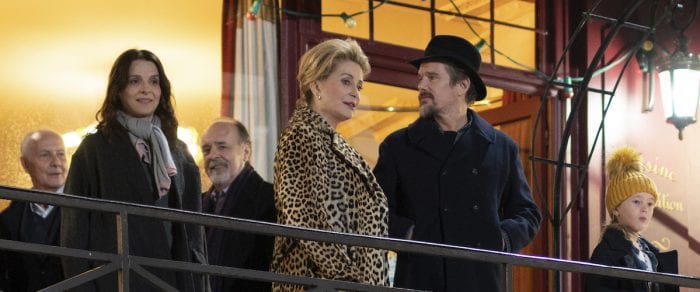
Reviewed By Jeffrey Sanzel
The Truth (La Vérité), acclaimed writer-director Hirokazu Kore-eda’s first film set outside his native Japan and not in his native language, is a fascinating study of family dysfunction that is equally heartfelt and scathing.
The film revolves around famous French actress Fabienne Dangeville (screen legend Catherine Deneuve) on the cusp of her memoir release. Her daughter, screenwriter Lumir (Juliette Binoche), arrives in Paris from the United States, and had expected to see the manuscript; she is chagrined to discover that it has already gone to print. When she does read the book, she confronts her mother with the liberties she has taken, particularly the portrayal of their history. In contrast to the idealized childhood presented in the book, the reality was distant and disconnected, a situation that has continued into adulthood. Fabienne’s answer: “My memories. My book.”
This is just the catalyst as the film doesn’t return to this initial conflict but instead focuses on their current relationship. Lumir is cornered into acting as Fabienne’s assistant as her mother navigates her current job, a low-budget science-fiction picture titled Memories of My Mother.
If it seems a bit on the nose, it is forgivable as the metaphor is much more complicated. The plot of the sci-fi film focuses on a terminally ill mother who lives in space so that she won’t succumb to her condition. She visits her daughter, Amy, at various times in her life. While she doesn’t age, Amy does. Fabienne has been cast as the eldest of the three Amy’s.
Looming in the background is the specter of Sarah, a woman who is referenced many times, but the connection is only gradually revealed. Sarah, an actress, was both Fabienne’s friend and rival. Lumir felt closer to Sarah than to her own mother, and Sarah’s death by suicide or accident — depending on who is telling the story — impacted Lumir deeply. There are also accusations of Fabienne’s complicity in the woman’s death. The suggestion that Sarah was a superior actress is something with which Fabienne has refused to come to terms.
All of these disparate pieces come together in the person of Manon (Manon Clavel) who is playing the mother in the film. Manon is presented as a brilliant up-and-comer and the heir to Sarah’s legacy. Fabienne is resentful of the woman’s talent and mistrustful of her sincerity.
Fabienne is a narcissist of the first order. In one of the earliest discussions, she is unaware which of her colleagues are alive or dead; when corrected, it is clear that she doesn’t really care. She is not even capable of apologizing to Luc (Alain Libolt), her long-suffering manager, and asks Lumir to write the apology for her. Deneuve is one of the great actors and creates a Fabienne whose monstrous ego doesn’t eclipse her insecurities. Deneuve makes her mercurial behavior not just wholly believable but strangely sympathetic.
Binoche never allows Lumir to become an object of pity. As a child who raised herself, she takes on emotionally caring for mother with a mix of amusement and resignation. Her exasperation with her mother is tempered by understanding. Binoche is incapable of giving a performance that is anything but truthful, and the film benefits from her ability to play humor and pain simultaneously. Her growing closeness to Manon (hearkening back to her relationship with Sarah) is a both delicate and subtle.
Clémentine Grenier as daughter Charlotte strikes a nice balance between precocious and present, and is particularly delightful in her scenes with Deneuve. Clavel is ideal as Manon, revealing an understated ferocity in the Memories of My Mother scenes and depth and warmth in her off-camera moments.
The film’s men not are not so much underdeveloped as they are intentionally ciphers. Ethan Hawke plays Hank, Lumir’s husband, a second-rate television and internet actor. He is a fraction of a man who only comes alive when reflected in the women around him. Libolt’s agent is even tacit in his rebellion. Sébastien Chassagne strikes the right subservient chord as the rather ineffectual and nameless director of Memories of My Mother.
Roger Van Hool appears briefly as Fabienne’s estranged husband, a sweet, wild-eyed figure of nominal importance in their lives. (Fabienne reported him as deceased in her book.) There is a wonderful bit of whimsy that poses the question of whether or not Fabienne has turned her ex-husband into a turtle that lives in the garden. This bit of fantasy is left shrewdly unanswered.
The film circles around themes of loneliness, emotional abandonment, and isolation as well as the fact that memory can never be fully trusted. It takes the ideas and threads them through both the narrative and in the film-within-the film. They are neatly balanced, with the professional world alternating with the personal. The truth, in the context of this story, is not so much subjective as it is flexible.
But, at the heart, is Deneuve’s self-absorbed Fabienne. Just when she is on the verge of connecting, she retreats, playing a wild game of emotional hide-and-seek to which only she knows the rules. “I’m an actress. I won’t tell the naked truth.” And it is clear she never does.
Rated PG, The Truth is now streaming On Demand.
 Join the Smithtown Historical Society, 239 Middle Country Road, Smithtown for an old fashioned drive-in movie night under the stars on Monday, July 20 featuring“Night at the Museum” (2006) on the main lawn at 8 p.m. Suggested donation of $15. Snack packs are available for pre-order. Gates open at 7 p.m. Tickets available at www.eventbrite.com. Questions? Call 631-265-6768.
Join the Smithtown Historical Society, 239 Middle Country Road, Smithtown for an old fashioned drive-in movie night under the stars on Monday, July 20 featuring“Night at the Museum” (2006) on the main lawn at 8 p.m. Suggested donation of $15. Snack packs are available for pre-order. Gates open at 7 p.m. Tickets available at www.eventbrite.com. Questions? Call 631-265-6768.
Reviewed by Jeffrey Sanzel
First-time director Natalie Erika James takes a new spin on the possessed residence genre with the atmospheric psychological horror film, Relic. James has co-written the heady screenplay with Christian White, and the result is ninety minutes of introspective dread that are grounded more in family than in fright. Relic had a buzzy debut at Sundance last year; it is equally arthouse and haunted house.
Three generations of women confront the dark but unexplained spirits possessing their family. When the elderly Edna (Robyn Nevin) disappears for three days and then suddenly reappears without explanation, daughter Kay (Emily Mortimer) and granddaughter Sam (Bella Heathcote) respond differently to the older woman’s erratic behavior.
The core of Relic is the portrait of a dysfunctional family staring down its matriarch’s slip into dementia. What is revealed is that years before, Edna’s grandfather suffered a fate similar to Edna’s. He died alone in a cabin on the property — the first structure put up on the land. (Kay has visions of both the old man and the cabin.) And while it no longer exists, pieces of it had been incorporated into the existing house, most notably the stained glass window now found in the front door.
It is as if the evil that destroyed the man followed it into the house, biding its time to possess its owner, in this case, Edna. But is it evil or illness? The answer is both.
While there are many traditional images, they feel fresh in James’s hands. In the opening moments, the house “breathes.” While an overflowing bathtub is a well-known trope, there is something about the water’s flow down the stairs that sets the tone for what will be the film’s creeping malevolence.
Initially, the house itself looks benign and suburban, if a bit cluttered. Yes, it is large and well-appointed, but this is not a caricature of the old dark house, and this is a very different kind of haunting. The black mold appears to be an insidious manifestation of the dementia, and it is consuming the family homestead.
At first, Edna seems to have a bruise on her chest. In actuality, the same mold is overrunning house and body. The possession is a slow poison that hovers around the edges before taking over; the metaphor is clear. Scattered around the house are Edna’s notes to herself — ranging from the simple “Flush” to the alarming “Don’t let it in.”
The layers and twists are neatly woven, alternating between the ever weakening bond between Edna and Kay and the malign forces that are present. The fact that they are joined makes the film unique as it is impossible to disconnect one from the other. The evil dwelling in the house is just as real as what has clearly been a disintegration of Edna’s mind.
This is a film that allows the narrative to slowly unravel. The scenes are short with staccato dialogue but the tempo remains at a slow burn for a majority of the time. It does not rely on gore or even visual scares. Instead, it allows us to peer into the shadows, unsure of what they — or we — are seeing.
It helps that all three actors — Mortimer, Nevin, and Heathcote — give understated and grounded performances. Nevin’s descent into confusion is marked by flashes of anger and disturbing behavior. There is a moment where she wanders away from the house and attempts to eat photographs before trying to bury the album itself. Wide-eyed, she looks at her daughter and cries, “Where is everyone?” It is a moment that is both horrifying and heart-breaking.
Mortimer’s struggle with ambivalence and obligation are palpable. Her love is mixed with resentment. She shows equal amounts of frustration and hurt in witnessing her mother’s desolation. Heathcote strikes the right balance in trying to be a loyal daughter and an attentive granddaughter. She also makes the climax (an extended sequence lost in the house’s impossible labyrinth) a showpiece in discovery. Both the spoken and unspoken pain and disappointment of this trio build the narrative.
Cinematographer Charlie Sarroff has effectively desaturated the color to the point of almost being absent. Robert Mackenzie’s eerie sound design — with ambient noise tamped down or oddly amplified — greatly enhances the off-kilter world. The distorted sounds of an empty washing machine and the gunshot bang of a bolt into a lock are jarring in just the right (wrong?) way.
For those looking for something different in the genre, Relic is an evasive but mysterious tale, cleverly flying in the face of traditional horror movie expectations. It masterfully blends many of the everyday fears for our loved ones with darker forces. Give it the time and it will stay with you long after its bizarre final moments.
Rated R, Relic is now streaming On Demand.
Reviewed By Jeffrey Sanzel
No single theatrical event of the past ten years has had the presence of the musical Hamilton. The powerhouse blockbuster crossed into everyday culture unlike any previous work in the American theater. Eleven Tony-Awards and the Pulitzer Prize is only the beginning of the list of accolades and honors Hamilton has received. Ardent fans in New York and across the country guaranteed years if not decades of sold-out performances.
In full disclosure, I saw the Broadway production as well as the national tour. In 1923, literary critic Samuel Taylor Coleridge said of Edmund Kean: “To see him act, is like reading Shakespeare by flashes of lightning.” Until I sat in a theater and watched Hamilton, I had not truly appreciated this statement. (Theatre Three alum/Long Island native Ryan Alvarado was the standby for Hamilton, Burr, and King George in the tour. I had the great joy of seeing his extraordinary performance in the titular role in San Francisco.)
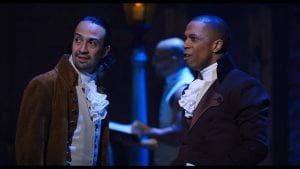 Hamilton: An American Musical (its full title) is the sole creation of the unparalleled Lin-Manuel Miranda who had already risen to prominence with his In the Heights. Miranda used the Ron Chernow biography Hamilton (2004) as his source, but this is no traditional musical biopic. With his unique book, music, and lyrics, he has fashioned a celebration unlike any other, and in doing so, has redefined what theater can be.
Hamilton: An American Musical (its full title) is the sole creation of the unparalleled Lin-Manuel Miranda who had already risen to prominence with his In the Heights. Miranda used the Ron Chernow biography Hamilton (2004) as his source, but this is no traditional musical biopic. With his unique book, music, and lyrics, he has fashioned a celebration unlike any other, and in doing so, has redefined what theater can be.
The score is flawless alchemy, drawing from hip hop, R&B, pop, and soul as well as traditional musical theater. Each song is a crafted gem of tune and words, perfectly fitting the moment and the character. The book alternates between the historical and the personal, shifting seamlessly from one to the other. Director Thomas Kail and choreographer Andy Blankenbuehler clearly understood Miranda’s intentions as their staging is both breathtaking and clear, synthesizing every moment, every beat.
The casting of people of color is not about color-blind or color-conscious casting. It is not a theatricalization or a nod towards political correctness. It can be taken as a bold statement about the founding of this country, including its references to immigration. It is a fusion of history and time, reflecting both its historical roots and the era in which it first appeared. However, it is a different world from when Hamilton opened in 2015, and the musical’s resonance is quite different in 2020.
The Hamilton that made its debut July 3 on Disney Plus is edited from three live performances in 2016 plus several scenes that were filmed in an empty theater to provide the opportunity for close-ups. Christmas has come early because this is a gift.
 Over the years, there have been various attempts to bring the experience of live theater to television with varying success. The American Playhouse presentation of Into the Woods (1991) was one of the stronger examples, featuring the show’s original cast. The Public Theatre’s presentation of The Apple Plays, composed of four plays by Richard Greenburg, worked extremely well. It’s interesting to note that a fifth Zoom/COVID play presented in April — without an audience — was the best of all of them.
Over the years, there have been various attempts to bring the experience of live theater to television with varying success. The American Playhouse presentation of Into the Woods (1991) was one of the stronger examples, featuring the show’s original cast. The Public Theatre’s presentation of The Apple Plays, composed of four plays by Richard Greenburg, worked extremely well. It’s interesting to note that a fifth Zoom/COVID play presented in April — without an audience — was the best of all of them.
The recent line of live productions made for television — a clumsy Sound of Music, an overly rewritten The Wiz, a painfully wrong-headed Peter Pan — are examples of how not to do it. Oddly, Grease managed to capture some of the excitement and energy of a live performance — highlighted by actors rushing from soundstage to soundstage in golf carts. While it’s not exactly theater, the “live” element was maintained.
This is a long way of saying that there is always a danger of trying to capture those “flashes of lighting.”
However, stage director Kail has wisely chosen to offer as close to a faithful representation of seeing it in the theater as possible. The majority of the taping is in wide-shots that allow for the scope of the production, but there is still a liberal use of close-ups as well as shots from backstage towards the audience, from the wings, etc. Kail emphasizes the big picture but knows when to bring us in to the individuals. The compensation for not being “in the room where it happens” is that we are given an opportunity to see myriad details that we certainly would have missed in the theater.
 One of the treasures of this recorded Hamilton is that it preserves the original company. And this cast is exceptional: a group of young (only two casts members were even in their forties) and astoundingly talented singer/dancer/actors execute a story with not only precision and commitment but unparalleled joy.
One of the treasures of this recorded Hamilton is that it preserves the original company. And this cast is exceptional: a group of young (only two casts members were even in their forties) and astoundingly talented singer/dancer/actors execute a story with not only precision and commitment but unparalleled joy.
As Hamilton, Miranda mines both the humor and pathos. The pain he shows in “It’s Quiet Up Town” is only matched by Phillip Soo’s as Eliza Schuler Hamilton singing “Burn.” Daveed Diggs plays the Marquis de Lafayette with great flair but it his outrageous Thomas Jefferson and “What’d I Miss?” that brings down the house.
Leslie Odom Jr. balances the fence-sitting reserve of Aaron Burr with his fierce, underlying desire for power and position; Odom brings reality to Burr’s complicated psyche and his “The Room Where It Happens” is a breath-taking showstopper.
Jonathan Groff literally foams at the mouth as King George, who is simultaneously hilarious and dangerous. Renée Elise Goldsberry’s exposed honesty as Angelica Schuyler shows the entire range of human emotions in “Satisfied,” the counterpoint to her sister’s “Helpless.”
Christopher Jackson brings dignity and humility to George Washington, especially in his farewell “One Last Time.” And while several principals play dual roles, none is better than Okieriete Onaodowan as the brash Hercules Mulligan and the almost blushing James Madison; it truly is like watching two entirely different performers.
Thousands of words have been written on Hamilton but none can capture the magic of this landmark work of art. It should — no, must — be seen. “Flashes of lightning?” Hamilton is a full-on electrical storm.
Rated PG-13, Hamilton: An American Musical is now available on Disney Plus.
